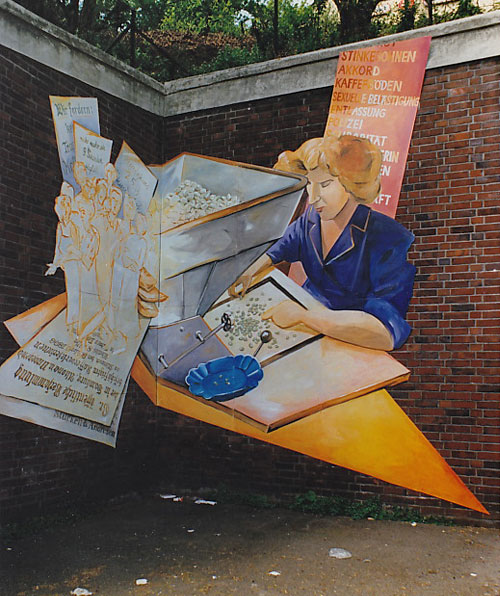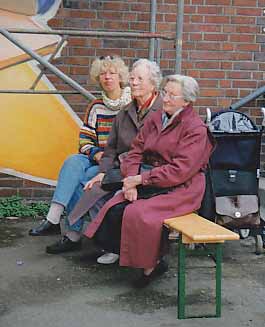The strike of the coffee bean sorters, 1996

"The strike of the coffee bean sorters"
Große Elbstraße 164, Staircase behind the house.
Design and realization: Hildegund Schuster.
Sponsors: NGG (German trade union), R&S Baugesellschaft, C. Schuster
Photo: Hildegund Schuster ©
To mark the hundredth anniversary of Hamburg’s famous dockers’ strike in 1896/7(1) the team of the FrauenFreiluftGalerie Hamburg (The Women's Open Air Gallery) devised a mural with the intention of commemorating an event that should remain firmly anchored in the collective historical memory of the city.
Six months before the dockers and shipyard workers went on strike, the coffee bean sorters in Hamburg and Altona downed tools, thus practically forming the "female spearhead" for the well-known strike action. In April 1896, hundreds of them protested against starvation wages and the stress of working on the coffee bean floors. In some firms the strike lasted up to six weeks.
One focus of the action was the strike by roughly 550 female workers at the Altona firm of Stucken & Andresen (Große Elbstraße 115), quite near to the mural.
Their demands
were to reduce the working day to 9 hours, a minimum hourly wage of 25 pfennigs (this was half the lowest wage paid to men in the port), no carrying of coffee bean sacks (that weighed about 80 kg) and curbing the imposition of fines by setting a daily limit of 10 pfennigs (fines were imposed among others for laughing, singing and sometimes even talking).
These substandard working conditions were further compounded by corporal punishment, the drudgery of piecework and sexual harassment by foremen and -women, as noted in informer reports for the political police.
There are two levels to Hildegund Schuster’s painting: the coffee bean sorter at the "vibrating conveyor" in the 1950s, and a fictional scene from the days of the strike in April 1896.
Here the focus is on the work involved in sorting the coffee beans according to size, colour and quality before the raw coffee is roasted. For example, no stinker beans may be included in the roasting process as this would spoil the whole batch.
Right up to the 1970s, sorting coffee beans by hand in Hamburg was a job that was only given to women. It was seasonal work that depended on the coffee harvest. The sedentary task was never as easy as it seemed, given the particular strain on the eyes from concentrated sorting for hours on end. Working under piecework conditions also put a constant strain on the whole body

Elisabeth von Dücker with
Inge Henker (in the middle)
and Hilde David (on the right)
from the Museum of Work's
"Women’s Working Party"
at the inauguration
of the mural on 13 May 1996
Photo: Women's Open Air Gallery Hamburg©
Lucie Martens, coffee bean sorter employed by Ocklemann in the Speicherstadt during the 1949 season, said in an interview: "The work really got on my nerves. Just imagine you have a monotonous job. In the evenings it's like you can see fleas dancing around in front of your eyes, you can’t really switch off".(2)
To our knowledge there are no photos of the strike. The artist therefore created the protest scene as a sketchy impression based on newspaper articles published at the time and reports submitted to the political police by informers who observed all workforce activities in those days.
In typical clothing and hairstyles, the strikers hold signs in their demands. Their "stage" is an enlarged newspaper announcement from the socialist workers’ publication "Hamburger Echo": "Public meeting for coffee bean sorters employed in Hamburg, Altona and surrounding areas on Thursday, 16 April 1896, half-past eight in the evening, at Kletts Gesellschaftsgarten, Wexstraße."
Coffee bean sorters in various companies went on strike, with greatly differing results.(3) At Strucken & Andresen, for example, nearly all demands made by the Compensation Committee were accepted 14 days into the strike. However, just after the strike came to an end this was followed by the first redundancies, specifically affecting those who had been involved in the strike.
The mural is painted on metal panels rather than directly on the brick wall. The many sharp angles raise it up from the reddish brown background and expressively underline the contents.
The word fragments act as a backrest for the coffee bean sorter and highlight the essentials of the painting in red-and-yellow shades: stinker beans, piecework, coffee bean floor, sexual harassment, redundancy, police, solidarity.
© Elisabeth von Dücker, 2011
(1) The dockers strike in Hamburg in 1896/97 is viewed as one of the key labour disputes in the German empire. It lasted from 21 November 1896 to 6 February 1897.
(2) Maria Beimel, Elisabeth von Dücker "Coffee doesn’t taste right if the beans are not sorted properly", in: "Not just figureheads. Women talk about working in the port of Hamburg", published by the Women’s Working Party and the Museum of Work (printed by ergebnisse Verlag), Hamburg, 1989, p. 103.
(3) ibid. p. 102-105.

